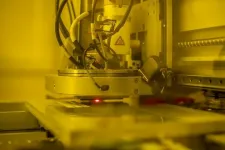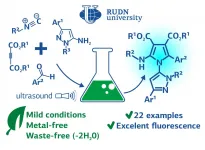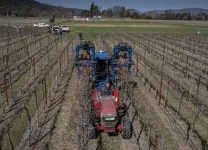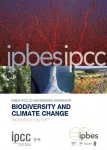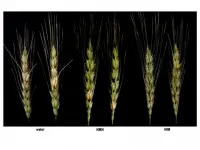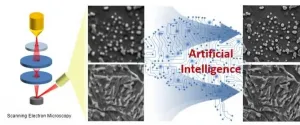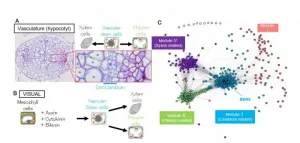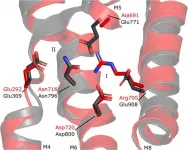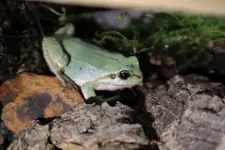Researchers' algorithm to make CRISPR gene editing more precise
2021-06-10
(Press-News.org) It eventually became a Nobel prize-winning revolution when researchers first engineered CRISPR as a gene editing technology for bacterial, plant, animal and human cells. The potential of the technology is great and span from curing genetically disposed diseases to applications in agricultural and industrial biotechnology, but there are challenges.
One such challenge consists of selecting a so-called gRNA molecule which should be designed to guide the Cas9 protein to the right location in the DNA where it will make a cut in relation to the gene editing.
"Typically, there are multiple possible gRNAs and they are not all equally efficient. Therefore, the challenge is to select the few that work with high efficiency and that is precisely what our new method does," says Yonglun Luo, Associate Professor Department of Biomedicine at Aarhus University.
The new method is developed from the researchers' new data and implementation of an algorithm, which gives a prediction on what gRNAs that work most efficiently.
"By combining our own data with publicly available data and including knowledge on the molecular interactions between gRNA, DNA and the CRISPR-Cas9 protein, we have succeeded in developing a better method," says Jan Gorodkin, professor at the Department of Veterinary and Animal Sciences at the University of Copenhagen.
Data, deep learning molecular interactions
Jan Gorodkin's research group with Giulia Corsi and Christian Anthon have collaborated with Yonglun Luo's research group in order to achieve the new results. The experimental part of the study was conducted by Luo's group while Gorodkin's group spearheaded the computer modelling.
"In our study, we have quantified the efficiency of gRNA molecules for more than 10.000 different sites. The work was achieved using a massive, high throughput library-based method, which would not be possible with traditional methods," says Yonglun Luo.
The researchers took their starting point concerning data generation in the concept of having a virus express gRNA and a synthetic target site in one cell at a time. The synthetic target sites have exactly the same DNA sequences as the corresponding target sites in the genome. Thus, these synthetic target sites are used as so-call surrogate target sites to capture the CRISPR-Cas9 editing efficiency. Together with colleagues from Lars Bolund Institute of Regenerative Medicine in BGI-Research and Harvard Medical School, they generated high quality CRISPR-Cas9 activity for over 10,000 gRNAs.
With this dataset of gRNAs with known efficiencies from low to high, the researchers were able to construct a model that could predict efficiencies of gRNAs which has not been seen before.
"In order to train an algorithm to become precise, one has to have a large dataset. With our library of viruses, we have obtained data that constitutes the perfect starting point for training our deep learning algorithm to predict the efficiency of gRNAs for gene editing. Our new method is more precise than other methods currently available," says Jan Gorodkin.
INFORMATION:
ELSE PRESS RELEASES FROM THIS DATE:
2021-06-10
Using a new 3D printing process, University of Nottingham researchers have discovered how to tailor-make artificial body parts and other medical devices with built-in functionality that offers better shape and durability, while cutting the risk of bacterial infection at the same time.
Study lead, Dr Yinfeng He, from the Centre for Additive Manufacturing, said: "Most mass-produced medical devices fail to completely meet the unique and complex needs of their users. Similarly, single-material 3D printing methods have design limitations that cannot produce a bespoke device with multiple biological or mechanical functions.
"But for the first time, using a computer-aided, multi-material ...
2021-06-10
RUDN and Shahid Beheshti University(SBU) chemist proposed an eco-friendly method for the synthesis of pyrrole and pyrazole derivatives with a wide range of applications in medicine: from antidepressants to anticancer. Moreover, the synthesized compounds possess interesting fluorescence features, and the bioactive scaffolds might attract great interest in the fields of clinical diagnostics and biomedical research in the future. The results are published in the Organic & Biomolecular Chemistry.
Heterocyclic compounds expose remarkable chemistry with significant applications in medicinal and organic chemistry, industry, and pharmaceutical. These compounds are widely ...
2021-06-10
Wine grape growers in California and elsewhere face increasing labor costs and severe labor shortages, making it difficult to manage and harvest a vineyard while maintaining profitability. Growers are increasingly turning to machines for pruning, canopy management and harvesting, but how well these practices are executed can substantially affect yield and quality. A new review by researchers at the University of California, Davis, published in the journal Catalyst, provides guidelines for growers to make the best use of machines.
"Wine grape laborers have been virtually nonexistent. People don't want to work in vineyards anymore because it's remote, tough work," said Kaan Kurtural, professor of viticulture and enology and extension ...
2021-06-10
BONN, 10 June - Unprecedented changes in climate and biodiversity, driven by human activities, have combined and increasingly threaten nature, human lives, livelihoods and well-being around the world. Biodiversity loss and climate change are both driven by human economic activities and mutually reinforce each other. Neither will be successfully resolved unless both are tackled together.
This is the message of a workshop report, published today by 50 of the world's leading biodiversity and climate experts.
The peer-reviewed workshop report is the product of a four-day virtual workshop between ...
2021-06-10
Kanazawa, Japan - Fungal diseases in cereal crops cause major economic losses and also threaten human and livestock health, because some fungi produce powerful toxins that might enter the food chain. Farmers use fungicides to control crop diseases, such as wheat head blight. Although agrochemicals are rigorously tested for safety, there can be concerns over chemical residues in food.
Now, researchers at Kanazawa University, in collaboration with colleagues at Ehime University and Nagoya University, have shown that the natural substance nicotinamide (NIM - a vitamin found in food and used as a dietary supplement) can help stimulate ...
2021-06-10
Curtin University researchers have helped uncover the four billion year old story of a lunar sample brought from the Moon to Earth, by the manned Apollo 17 mission more than 50 years ago.
The global research collaboration, involving scientists from the UK, Canada, Sweden and Australia, aimed to analyse the ancient rock sample through a modern lens to find out its age, which crater it came from and its geological trajectory.
That modern lens was provided, in part, by both Curtin's Geoscience Atom Probe Facility* and Space Science and Technology Centre* (SSTC) where the research team was ...
2021-06-10
With the onset of the 4th industrial revolution, artificial intelligence has recently been utilized in smartphone cameras, providing functions such as auto-focusing, face recognition, and 100x zoom, to dramatically improve our daily life. It has also been applied to research and development of new materials.
A joint research team from POSTECH and Korea Institute of Materials Science (KIMS) has applied deep learning to the scanning electron microscopy (SEM) system to develop a technique that can detect and improve the quality of SEM images without human oversight. The EMS is an essential material analysis equipment used for developing new materials. The findings from this research were recently published ...
2021-06-10
An inter-university research group has succeeded in constructing the gene expression network behind the vascular development process in plants. They achieved this by performing bioinformatics analysis using the 'VISUAL' (*1) tissue culture platform, which generates vascular stem cells (*2) from leaf cells. In this network, they also discovered a new BES/BZR transcription factor (*3), BEH3, which regulates vascular stem cells. In addition, they illuminated a novel vascular cell maintenance system whereby BEH3 competes with other transcription factors from the same BES/BZR family in order to stabilize vascular stem ...
2021-06-10
Cell viability require that a variety of functions at the cell membrane are maintained properly. P-type ATPases translocate substrates across the membrane, and they have evolved into different types taking care of specific substrates within a diverse range. Now, key structural aspects have been described on how two different types of P-type ATPases - a Ca2+ transporting Ca2+ -ATPase and a lipid transporting P4-ATPase - have adapted to different substrates and physical environments.
Many bacteria export intracellular calcium using active transporters homologous to the well-described ...
2021-06-10
Researchers from Tel Aviv University took part in a new international study proposing an amendment to the widely accepted theory on the extinction of animal species - by moving the focus from the animal's body size to its reproductive capacity. The researchers found gaps and incompatibilities between mammals and amphibians in the relation between body size and extinction risk: Whereas large mammals bear a smaller number of offspring per birth, leading to higher risk of extinction, larger amphibian females lay more eggs, reducing the threat to the species.
The researchers analyzed data from databases on both extinction risks and reproductive capacities of various species of amphibians (e.g., frogs and salamanders). Contributors to the ...
LAST 30 PRESS RELEASES:
[Press-News.org] Researchers' algorithm to make CRISPR gene editing more precise
